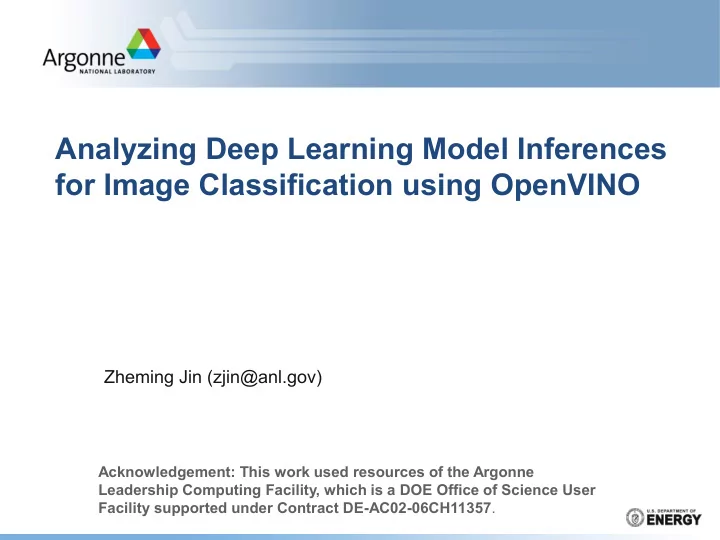

Analyzing Deep Learning Model Inferences for Image Classification using OpenVINO Zheming Jin (zjin@anl.gov) Acknowledgement: This work used resources of the Argonne Leadership Computing Facility, which is a DOE Office of Science User Facility supported under Contract DE-AC02-06CH11357 .
Motivation Deep learning model inference on an integrated GPU may be desirable Deep learning model inference on a CPU is still of interests to many people Gain a better understanding of how a model is executed using the vendor-specific high-performance library on a GPU, and the effectiveness of using the half-precision floating-point format and 8-bit model quantization
The OpenVINO Toolkit Image credit: Intel
Summary of optimizing and deploying a pretrained Caffe model Convert a Caffe model to intermediate representation (IR) using the Model Optimizer for Caffe – IR consists of .xml (network topology) and .bin (weights and biases binary) files – Optimized IR: node merging, drop unused layers, etc. Test the model using the Inference Engine via the sample applications – C++ APIs to read IR, set input/output formats, and execute the model on a device – Heterogeneous plugin for each device (CPU, GPU, FPGA, etc.)
Experimental setup (continued) Intel Xeon E3-1585v5 microprocessor – CPU: four cores and each core supports two threads – Integrated GPU: 72 execution units OpenCL 2.1 NEO Driver: version 19.48.14977 API version of the inference engine is 2.1 CPU/GPU plugins build version is 32974 Operating system is Red Hat Linux Enterprise 7.6 (kernel version 3.10.0-957.10.1)
Experimental setup Choose Pretrained Caffe models, which will be shown in the next slide, for image classification from Open Model Zoo Calibration dataset is 2000, a subset of ImageNet 2012 validation set Measure the latency of model inference – Batch size and the number of infer requests are one – Latency is averaged over 32 iterations Note INT8 inference on the integrated GPU and FP16 inference on the CPU are currently not supported
Performance of 14 pretrained Caffe models for image classification Results obtained using an Intel Xeon E3-1585 v5 microprocessor CPU: four cores, two thread per core, running at 3.5 GHz Integrated GPU (iGPU): 72 executing units running at 1.1.5 GHz
Performance comparison between the CPU and GPU Results obtained using an Intel Xeon E3-1585 v5 microprocessor CPU: four cores, two thread per core, running at 3.5 GHz iGPU: 72 executing units running at 1.1.5 GHz
Implementation of Squeezenet1.1 using clDNN
Squeezenet 1.1 on the CPU (MKLDNN) and GPU
Comparison to other studies [1,2] FP32 image classification and object detection on an Intel Skylake 18-core CPU with the AVX512 instruction set – Current work is focused on the performance improvement using an AVX-2 CPU which is common for edge devices Performance of three image classification models using OpenVINO on the AWS DeepLens platform that features an Intel Graphics HD 505 iGPU – Current work obtains 10X more speedup on our iGPU using the current toolkit [1] Liu, Y., Wang, Y., Yu, R., Li, M., Sharma, V. and Wang, Y., 2019. Optimizing CNN Model Inference on CPUs. In 2019 USENIX Annual Technical Conference (pp. 1025-1040). [2] Wang, L., Chen, Z., Liu, Y., Wang, Y., Zheng, L., Li, M. and Wang, Y., 2019, August. A Unified Optimization Approach for CNN Model Inference on Integrated GPUs. In Proceedings of the 48th International Conference on Parallel Processing
Summary The quantized models are 1.02X to 1.56X faster than the FP32 models on the target CPU The FP16 models are 1.1X to 2X faster than the FP32 models on the target iGPU The iGPU is on average 1.5X faster than the CPU for the FP32 models
Thanks
Recommend
More recommend